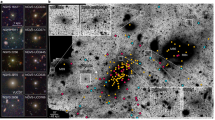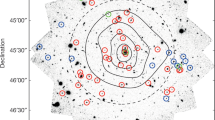Abstract
Recent studies of galaxies ∼2–3 Gyr after the Big Bang have revealed large, rotating disks, similar to those of galaxies today1,2. The existence of well-ordered rotation in galaxies during this peak epoch of cosmic star formation indicates that gas accretion is likely to be the dominant mode by which galaxies grow, because major mergers of galaxies would completely disrupt the observed velocity fields. But poor spatial resolution and sensitivity have hampered this interpretation; such studies have been limited to the largest and most luminous galaxies, which may have fundamentally different modes of assembly from those of more typical galaxies (which are thought to grow into the spheroidal components at the centres of galaxies similar to the Milky Way). Here we report observations of a typical star-forming galaxy at z = 3.07, with a linear resolution of ∼100 parsecs. We find a well-ordered compact source in which molecular gas is being converted efficiently into stars, likely to be assembling a spheroidal bulge similar to those seen in spiral galaxies at the present day. The presence of undisrupted rotation may indicate that galaxies such as the Milky Way gain much of their mass by accretion rather than major mergers.
This is a preview of subscription content, access via your institution
Access options
Subscribe to this journal
Receive 51 print issues and online access
$199.00 per year
only $3.90 per issue
Buy this article
- Purchase on Springer Link
- Instant access to full article PDF
Prices may be subject to local taxes which are calculated during checkout


Similar content being viewed by others
References
Genzel, R. et al. The rapid formation of a large rotating disk galaxy three billion years after the Big Bang. Nature 442, 786–789 (2006)
Forster-Schreiber, N. M. et al. SINFONI integral field spectroscopy of z ∼ 2 UV-selected galaxies. Astrophys. J. 645, 1062–1075 (2006)
Law, D. et al. Integral field spectroscopy of high redshift star-forming galaxies with laser-guide star adaptive optics. Astrophys. J. 669, 929–946 (2007)
Nesvadba, N. P. H. et al. Lyman break galaxies under a microscope: the small-scale dynamics and mass of an arc in the cluster 1E 0657-56. Astrophys. J. 650, 661–668 (2006)
Ellis, R. S., Santos, M. R., Kneib, J.-P. & Kuijken, K. A faint star-forming system viewed through the lensing cluster Abell 2218: first light at z = 5.6? Astrophys. J. 560, 119–122 (2001)
Kneib, J.-P., Ellis, R. S., Santos, M. R. & Richard, J. A probable z ∼ 7 galaxy strongly lensed by the rich cluster A2218: exploring the dark ages. Astrophys. J. 607, 697–703 (2004)
Swinbank, M. et al. Resolved spectroscopy of a gravitationally lensed L* Lyman-break galaxy at z ∼ 5. Mon. Not. R. Astron. Soc. 376, 479–491 (2007)
Smail, I. et al. A very bright highly magnified Lyman break galaxy at z = 3.07. Astrophys. J. 654, L33–L36 (2007)
Dye, S., Smail, I., Swinbank, A. M., Ebeling, H. & Edge, A. C. Separation of the visible and dark matter in the Einstein ring LBG J213512.73-010143. Mon. Not. R. Astron. Soc. 379, 308–316 (2007)
Larkin, J. et al. OSIRIS: a diffraction limited integral field spectrograph for Keck. N. Astron. Rev. 50, 362–364 (2006)
Bouwens, R. J., Illingworth, G. D., Blakeslee, J. P., Broadhurst, T. J. & Franx, M. Galaxy size evolution at high redshift and surface brightness selection effects. Astrophys. J. 611, L1–L4 (2004)
Abraham, R. et al. The star formation history of the Hubble sequence: spatially resolved colour distributions of intermediate-redshift galaxies in the Hubble Deep Field. Mon. Not. R. Astron. Soc. 279, L47–L52 (1996)
Coppin, K. E. K. et al. A detailed study of gas and star formation in a highly magnified Lyman break galaxy at z = 3.07. Astrophys. J. 665, 936–943 (2007)
Kennicutt, R. C. Star formation along the Hubble Sequence. Annu. Rev. Astron. Astrophys. 36, 189–232 (1998)
Erb, D. et al. α observations of a large sample of galaxies at z ∼ 2. Astrophys. J. 647, 128–139 (2006)
Shapley, A. et al. The rest-frame optical properties of z ∼ 3 galaxies. Astrophys. J. 562, 95–123 (2001)
Heckman, T. M. Galactic superwinds circa 2001. ASP Conference Proc. 254, 292–304 (2002)
Pettini, M. & Pagel, B. [O III]/[NII] as an abundance indicator at high redshift. Mon. Not. R. Astron. Soc. 348, L59–L63 (2004)
Pilyugin, L. S. & Thuan, T. X. Oxygen abundance determination in H II regions: the strong line intensities–abundance calibration revisited. Astrophys. J. 631, 231–243 (2005)
Solomon, P. M. & Vanden Bout, P. A. Molecular gas at high redshift. Annu. Rev. Astron. Astrophys. 43, 677–725 (2005)
Solomon, P. M., Downes, D., Radford, S. J. E. & Barrett, J. W. The molecular interstellar medium in ultraluminous infrared galaxies. Astrophys. J. 478, 144–161 (1997)
Tacconi, L. et al. Submillimeter galaxies at z ∼ 2: evidence for major mergers and constraints on lifetimes, IMF, and CO-H2 conversion factor. Astrophys. J. 680, 246–262 (2008)
Erb, D. K. et al. The stellar, gas, and dynamical masses of star-forming galaxies at z ∼ 2. Astrophys. J. 646, 107–132 (2006)
Acknowledgements
We thank J. Lyke for assistance with the Keck observations, and R. Bower, K. Coppin, M. Lehnert, R. Genzel, D. Erb, D. Law, A. Shapley, A. Jenkins, P. Salucci and T. Theuns for discussions. The OSIRIS data were obtained at the W. M. Keck Observatory, which is operated as a scientific partnership between the California Institute of Technology, the University of California and NASA. The observatory was made possible by the financial support of the W. M. Keck Foundation. The SINFONI data are based on observations made with the ESO Telescopes at the Paranal Observatories. A.M.S. acknowledges financial support from STFC, and I.R.S. and R.S.E. acknowledge financial support from the Royal Society.
Author information
Authors and Affiliations
Corresponding author
Supplementary information
Supplementary Information
This file contains Supplementary Data, Supplementary Figures 1-2 with Legends and Supplementary References (PDF 934 kb)
PowerPoint slides
Rights and permissions
About this article
Cite this article
Stark, D., Swinbank, A., Ellis, R. et al. The formation and assembly of a typical star-forming galaxy at redshift z ≈ 3. Nature 455, 775–777 (2008). https://doi.org/10.1038/nature07294
Received:
Accepted:
Issue Date:
DOI: https://doi.org/10.1038/nature07294
This article is cited by
-
Tidal dwarf galaxies at intermediate redshifts
Astrophysics and Space Science (2012)
-
High star formation rates as the origin of turbulence in early and modern disk galaxies
Nature (2010)
-
Cold streams in early massive hot haloes as the main mode of galaxy formation
Nature (2009)
Comments
By submitting a comment you agree to abide by our Terms and Community Guidelines. If you find something abusive or that does not comply with our terms or guidelines please flag it as inappropriate.



